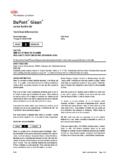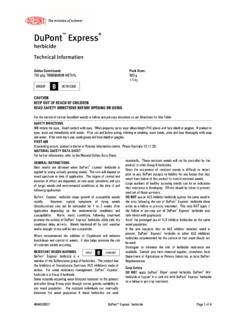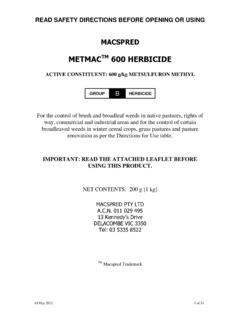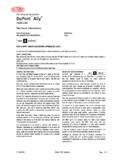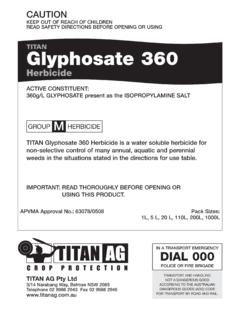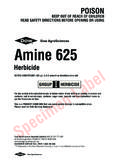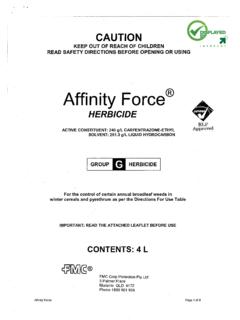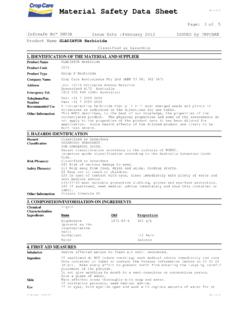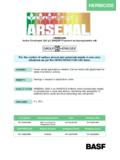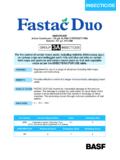Transcription of Confidor 200SC MSDS 1107 - HerbiGuide - Home
1 MATERIAL SAFETY DATA SHEET Date of Issue: November 19, 2007 Confidor 200 SC insecticide Page 1 of 6 1. IDENTIFICATION OF THE MATERIAL AND SUPPLIER Product name Confidor 200 SC insecticide Other names None Product codes 4952897 (1 L), 4952900 (10 L) Chemical group Chloronicotinyl Recommended use Agricultural insecticide Formulation Suspension concentrate Supplier Bayer CropScience Pty Ltd ABN 87 000 226 022 Address 391 - 393 Tooronga Road, East Hawthorn Victoria 3123, Australia Telephone (03) 9248 6888 Facsimile (03) 9248 6800 Website Contact Development Manager (03) 9248 6888 Emergency Telephone Number 1800 033 111 Orica SH&E Shared Services 2.
2 HAZARDS IDENTIFICATION EMERGENCY OVERVIEW HAZARDOUS SUBSTANCE (see Risk phrase below) NON DANGEROUS GOOD Harmful to aquatic organisms Hazard classification Hazardous (National Occupational Health and Safety Commission - NOHSC) Risk phrases R22 Harmful if swallowed. R43 May cause sensitisation by skin contact. Safety phrases See Sections 4, 5, 6, 7, 8, 10, 12, 13 ADG classification Not classified as a Dangerous good for transport by road or rail according to the Australian Code for the Transport of Dangerous Goods by Road and Rail. SUSDP classification (Poisons Schedule) Schedule 5 (Standard for the Uniform Scheduling of Drugs and Poisons) 3.
3 COMPOSITION / INFORMATION ON INGREDIENTS Ingredients CAS Number Concentration (g/L) Imidacloprid [138261-41-3] 200 Isothiazolone antifungal agent [55965-84-9] Other ingredients, including emulsifiers, stabilizers, antifungal agents and water (non-hazardous) 950 MATERIAL SAFETY DATA SHEET Date of Issue: November 19, 2007 Confidor 200 SC insecticide Page 2 of 6 4. FIRST AID MEASURES If poisoning occurs, immediately contact a doctor or Poisons Information Centre (telephone 13 11 26), and follow the advice given. Show this Material Safety Data Sheet to the doctor. Inhalation If inhaled, remove to fresh air and keep warm and at rest.
4 Seek medical advice if at all worried. Skin contact Carefully remove contaminated clothing. Wash affected areas with soap and water. Seek medical advice if at all worried. Eye contact Rinse eyes immediately with clean water for at least 15 minutes. Obtain medical advice. Ingestion Obtain immediate medical advice as above. Do not induce vomiting unless advised to do so by doctor or Poisons Information Centre. Do not give anything by mouth to an unconscious or semi conscious person. First Aid Facilities Provide washing facilities in the workplace. Medical attention Information for the physician: The active ingredient, imidacloprid belongs to the chemical group, chloronicotinyl or neonicotinoid.
5 Therapeutic measures: Basic aid, decontamination, symptomatic treatment. Symptoms Local: None expected. Systemic: Apathetic state, depressed muscular tone, respiratory disturbances and trembling. Muscular cramps are also possible in severe cases of poisoning. Treatment Local: See First Aid Measures above. Systemic: Symptomatic (nicotine-like effects). Check blood pressure and pulse rate frequently, as bradycardia and hypotonia are possible. Provide supportive measures for respiratory function and cardiac action. Give artificial respiration if signs of paralysis appear. Additional therapeutic measures involve elimination of the substance from the body or acceleration of its excretion (gastric lavage, saline laxatives, activated charcoal).
6 Antidote: None known. Contraindications: Absorption promoting agents such as alcoholic beverages and milk. Oils and fats are of no particular use, as the active ingredient has low liposolubility. 5. FIRE FIGHTING MEASURES Extinguishing media Water, foam, extinguishing powder, carbon dioxide, sand. Hazards from combustion products In a fire, formation of hydrogen chloride, hydrogen cyanide, carbon monoxide and nitrogen oxides can be expected. Precautions for fire fighters Firefighters should wear full protective gear, including self-contained breathing apparatus (AS/NZS 1715/1716). Keep unnecessary people away.
7 If it can be done safely, remove intact containers from the fire. Otherwise, use water spray to cool them. Bund area with sand or earth to prevent contamination of drains or waterways. Dispose of fire control water or other extinguishing agent and spillage safely later. Do not release contaminated water into the environment. MATERIAL SAFETY DATA SHEET Date of Issue: November 19, 2007 Confidor 200 SC insecticide Page 3 of 6 5. FIRE FIGHTING MEASURES - continued Hazchem code Not applicable 6. ACCIDENTAL RELEASE MEASURES Avoid contact with the spilled material or contaminated surfaces. When dealing with spills do not eat, drink or smoke and wear protective clothing and equipment as described in Section 8 - PERSONAL PROTECTION.
8 Keep people and animals away. Prevent spilled material from entering drains or watercourses. Contain spill and absorb with earth, sand, clay, or other absorbent material. Collect and store in properly labelled, sealed drums for safe disposal. Deal with all spillages immediately. If contamination of drains, streams, watercourses, etc. is unavoidable, warn the local water authority. 7. HANDLING AND STORAGE Handling Keep out of reach of children. Repeated exposure may cause allergic disorders. Avoid contact with eyes and skin. Wash hands after use. After each day s use, wash gloves, goggles and contaminated clothing.
9 Storage Store in the closed, original container in a cool, well-ventilated area. Do not store for prolonged periods in direct sunlight. Flammability Not flammable water based product. 8. EXPOSURE CONTROLS / PERSONAL PROTECTION Exposure standards The NOHSC exposure standard (TWA) for glycerin mist is: 10 mg/m Exposure standard Time Weighted Average (TWA) means the average airborne concentration of a particular substance when calculated over a normal eight-hour working day, for a five-day working week. Biological limit values None allocated. Engineering controls Control process conditions to avoid contact.
10 Use in a well-ventilated area only. Personal Protective Equipment Eyes: Clothing: Gloves: Respiratory: Wear goggles. Wear cotton overalls buttoned to the neck and wrist and a washable hat. Wear elbow-length PVC gloves. Wear a disposable mask if inhalation is likely. 9. PHYSICAL AND CHEMICAL PROPERTIES Appearance: White to slightly beige liquid suspension Odour: Slight characteristic pH: Vapour pressure: 4 x 10-7 mPa at 20 C (imidacloprid) Vapour density: Not available Boiling point: Not available Freezing/melting point: Not available Solubility: Miscible with water Specific Gravity: at 20 C MATERIAL SAFETY DATA SHEET Date of Issue: November 19, 2007 Confidor 200 SC insecticide Page 4 of 6 9.
